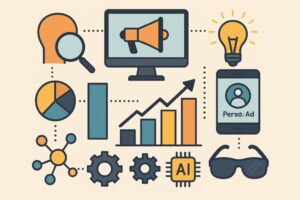Key Takeaways
- Understanding the importance of data in crafting personalized advertising.
- Learn how to leverage data analytics to increase advertising efficiency.
- Identify key trends and technologies shaping the future of data-driven advertising.

Table of Contents
- Introduction to Data-Driven Advertising
- The Role of Big Data in Modern Advertising
- Key Components of a Data-Driven Strategy
- How to Collect and Analyze Advertising Data
- Crafting Personalized Ad Campaigns
- Leveraging Technology for Better Results
- Case Studies of Successful Data-Driven Campaigns
- Future Trends in Data-Driven Advertising
- Conclusion
Introduction to Data-Driven Advertising
In the rapidly evolving landscape of digital marketing, data-driven advertising has emerged as a pivotal strategy. Businesses are turning to big data advertising solutions to craft campaigns that resonate more deeply with their audiences. By leveraging data, companies can now move away from one-size-fits-all approaches, tailoring messages that cater to the specific preferences and behaviors of their consumers. This personalization fosters stronger connections and often leads to increased engagement and conversions. The traditional broadcast methods are dwindling, as marketers discover the value in creating bespoke experiences for consumers who demand more personalized connections.
Harnessing the power of data offers a clear competitive advantage. Organizations that integrate data-driven methods have reported greater efficiency in ad spend and better targeting accuracy. The shift from traditional marketing methodologies to those centered on data is driven by the need for dynamic, responsive, and consumer-focused campaigns that keep pace with ever-changing market demands. As more channels and platforms emerge, this adaptability will be key in maintaining a brand’s presence and relevance in an increasingly crowded market.
The Role of Big Data in Modern Advertising
Big data plays an instrumental role in transforming advertising into a more precise science. By analyzing vast amounts of consumer data, marketers gain valuable insights into buyer behavior, preferences, and purchasing habits. These insights allow for the creation of campaigns that are both timely and relevant. The immediate and real-time nature of data collection further enables advertisers to adjust their strategies on the fly, matching the rapid pace at which consumer preferences evolve. This agility not only helps in retaining customer interest but also aids in building long-term loyalty.
Organizations that incorporate big data into their advertising frameworks report enhanced decision-making capabilities. They move beyond guesswork into strategic planning, with data serving as a solid foundation for all marketing efforts. Big data becomes a crucial asset in identifying market gaps, predicting upcoming trends, and anticipating the potential needs of customers, thereby allowing businesses to stay ahead of the curve and capitalize on new opportunities.
Key Components of a Data-Driven Strategy
A successful data-driven strategy begins with clearly defining marketing objectives. Establishing clear goals guides the subsequent steps of identifying target audiences and selecting appropriate channels for engagement. Another vital component is developing key performance indicators (KPIs) that serve as benchmarks to evaluate the campaign’s success. KPIs provide measurable milestones that help marketers assess progress and make necessary adjustments to optimize performance continually.
These components form the backbone of any data-centric initiative. Regular monitoring and adjustment based on KPI feedback ensure the advertising effort remains effective and agile. Additionally, a feedback loop involving these KPIs allows marketers to learn from past campaigns, refining their strategies and sharpening their focus for future efforts.
How to Collect and Analyze Advertising Data
Collecting relevant data requires a multifaceted approach. Marketers employ tools such as online surveys, social media analytics, and customer feedback loops to gather essential consumer insights. Once collected, data analytics tools help decipher this information, transforming raw data into actionable insights. Essential analytics tools include platforms like Google Analytics for web data, and social media analytics tools like Hootsuite and Buffer, which help gather information on consumer preferences across various platforms.
The analysis phase is where the magic happens. By understanding trends and patterns, advertisers can predict future behaviors, allowing them to tailor campaigns accordingly. Advanced analytics can segment audiences into increasingly specific groups, offering marketers the chance to design messages that resonate deeply with each micro-segment. This tailoring ensures that the right message reaches the right person at the right time, enhancing the efficacy of a campaign and maximizing returns.
Crafting Personalized Ad Campaigns
Personalization in advertising takes center stage in the world of data-driven strategies. Companies segment audiences based on specific criteria, such as demographics, interests, and past interactions, to deliver personalized messages that speak directly to individual needs and desires. This approach ensures that advertisements are no longer interruptions but become useful, inviting interactions that can lead to valuable brand relationships.
The results of such tailored campaigns are evident in heightened user engagement and improved conversion rates, proving that personalization is more than a buzzword—it’s a necessity in today’s competitive market. Personalized approach also encourages a deeper level of customer loyalty, as consumers begin to perceive the brand as attuned to their specific needs and preferences, leading to repeat purchases and brand advocacy.
Leveraging Technology for Better Results
The integration of AI and machine learning in advertising strategies provides unprecedented opportunities to optimize performance. These technologies bring sophisticated capabilities to the table, such as predictive analytics, helping businesses anticipate what consumers want before they even express an interest. Predictive analytics spans from foreseeing click-through rates to understanding purchase probabilities, thus offering a comprehensive picture of the consumer journey.
Additionally, technologies like AI allow marketers to automate repetitive tasks, focusing more on creative and strategic activities. For example, through machine learning, campaigns can be modified in real-time to enhance effectiveness based on incoming data. AI-driven tools also facilitate dynamic customer experiences by making real-time adjustments to optimize content delivery. Further reading on the impact of such technologies can be found in the Gartner survey.
Case Studies of Successful Data-Driven Campaigns
Real-world examples bring theory into practice. Companies like Netflix and Amazon have mastered data-driven advertising. Netflix, for example, uses data to recommend content, vastly improving customer retention and engagement. Their algorithms sift through user viewing habits, delivering suggestions with a high probability of delighting their audience. Similarly, Amazon’s recommendation engine, powered by sophisticated data analysis, has been pivotal to their success in increasing sales and maintaining consumer loyalty, constantly learning from user interactions and refining product suggestions.
These case studies illustrate how data-driven advertising strategies can lead to impressive returns on investment when implemented correctly. They demonstrate the power of data to transform raw insights into actionable strategies that align with both business objectives and customer desires.
Future Trends in Data-Driven Advertising
Looking ahead, the future of data-driven advertising appears bright and full of potential. Emerging technologies like virtual reality (VR) and augmented reality (AR) are set to revolutionize the way consumers interact with advertisements. These immersive technologies offer brands the chance to create deeply engaging experiences that captivate and convert viewers into customers.
As data privacy regulations become stricter, marketers must innovate to find compliant ways to collect and utilize consumer data. Building trust with transparency will become even more essential as consumers grow increasingly concerned about their data footprint. These trends suggest a future where advertising strategies are even more intricately tailored and consumer-focused, driven by data yet tempered with a respect for consumer privacy. Adapting to these changes will be crucial for maintaining consumer trust and achieving advertising success.
Conclusion
In conclusion, data-driven advertising has reshaped the modern marketing landscape by enabling unprecedented levels of personalization, precision, and performance. By leveraging big data and advanced analytics, businesses can tailor messages that resonate deeply with individual consumer segments, driving higher engagement and more meaningful interactions. The integration of technologies such as AI and machine learning has further amplified these capabilities, making campaigns more dynamic, responsive, and effective in real-time. Companies that invest in understanding and utilizing data are better equipped to adapt to consumer behaviors and market fluctuations, gaining a competitive edge in the crowded digital arena. As traditional mass advertising continues to decline, the shift toward data-centric strategies becomes not only advantageous but essential for sustained growth.
Looking forward, the future of data-driven advertising is defined by both exciting innovation and the need for ethical responsibility. Technologies like AR and VR are opening new avenues for immersive consumer experiences, while evolving privacy regulations challenge marketers to prioritize transparency and trust. Success in this new era will rely on a brand’s ability to balance cutting-edge personalization with respect for user data and consent. Forward-thinking companies will need to stay agile, leveraging emerging tools while aligning their strategies with changing consumer expectations. Ultimately, the brands that thrive will be those that not only harness the power of data but do so with integrity, creativity, and a deep understanding of their audiences.







